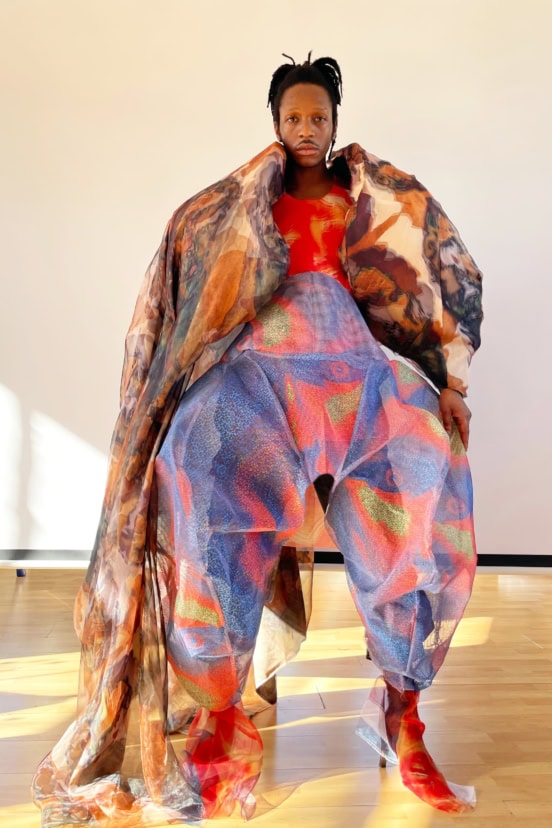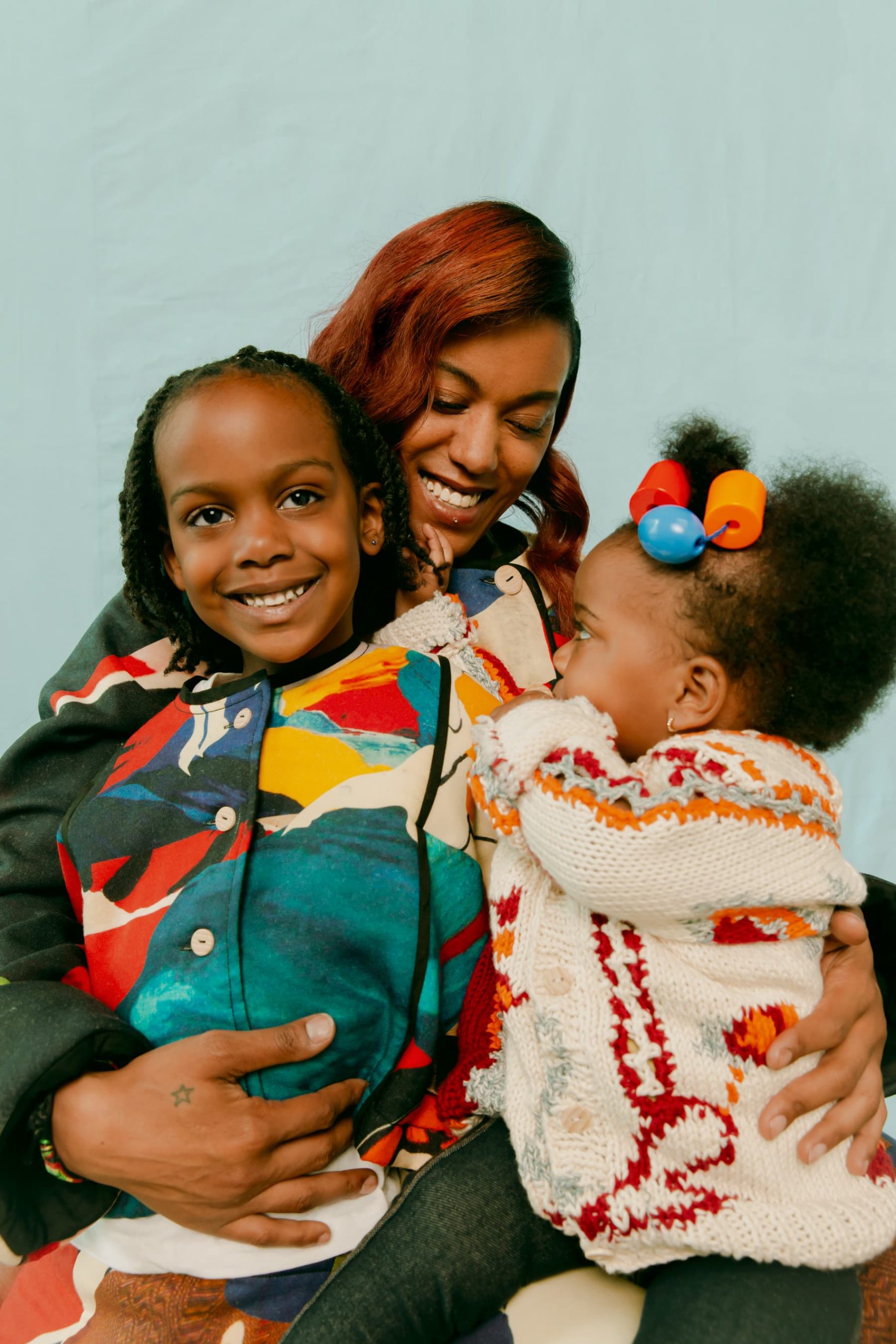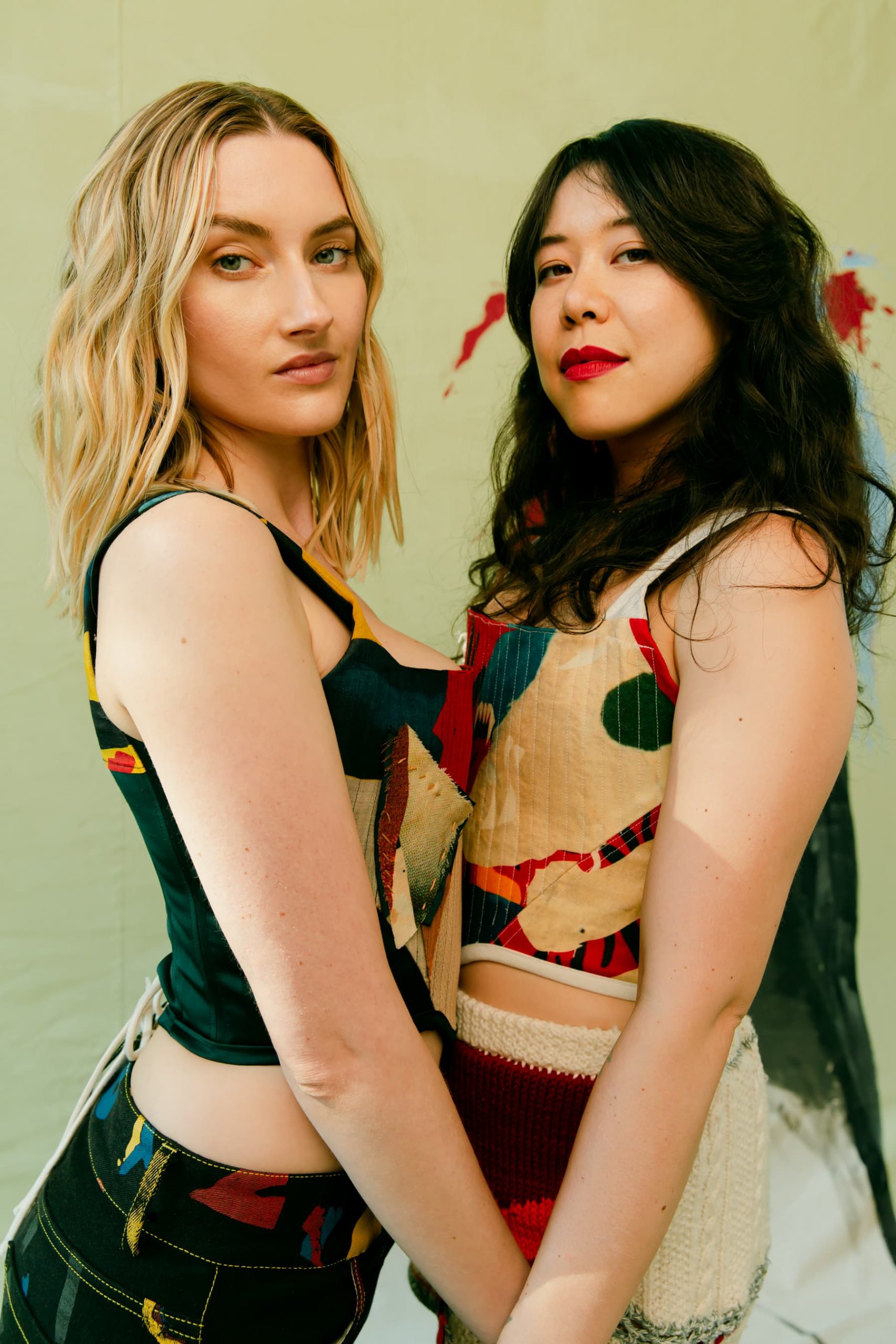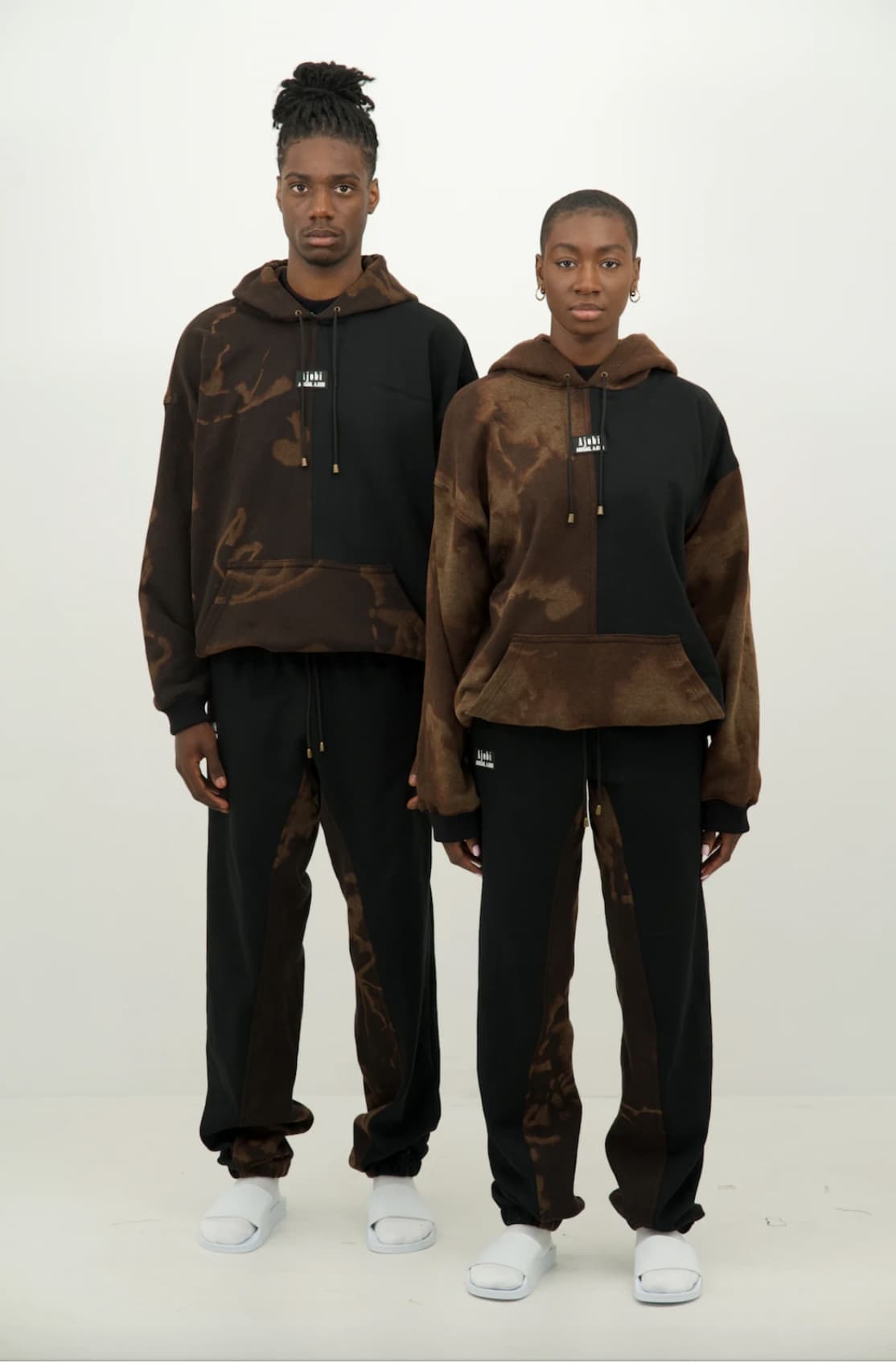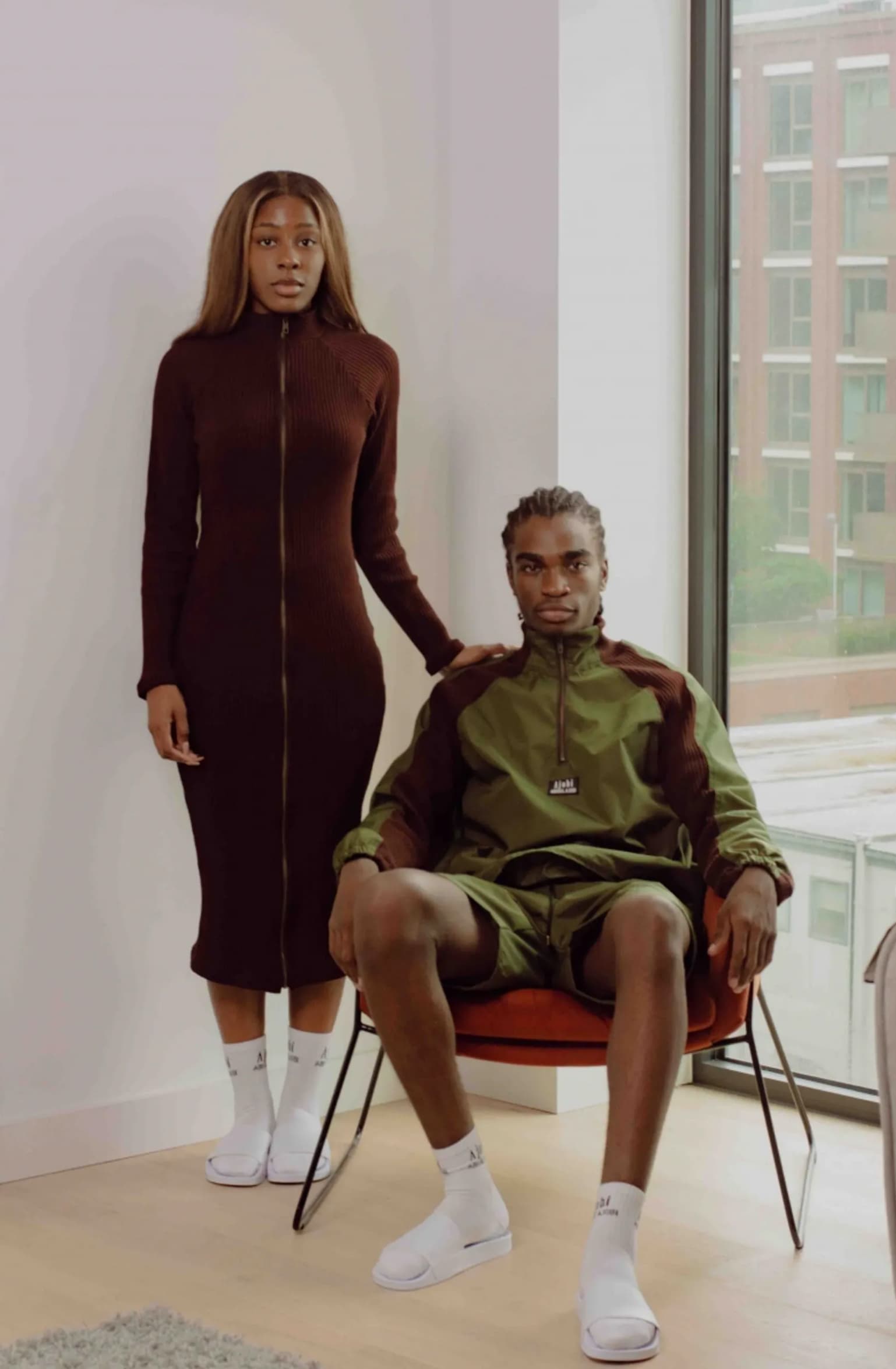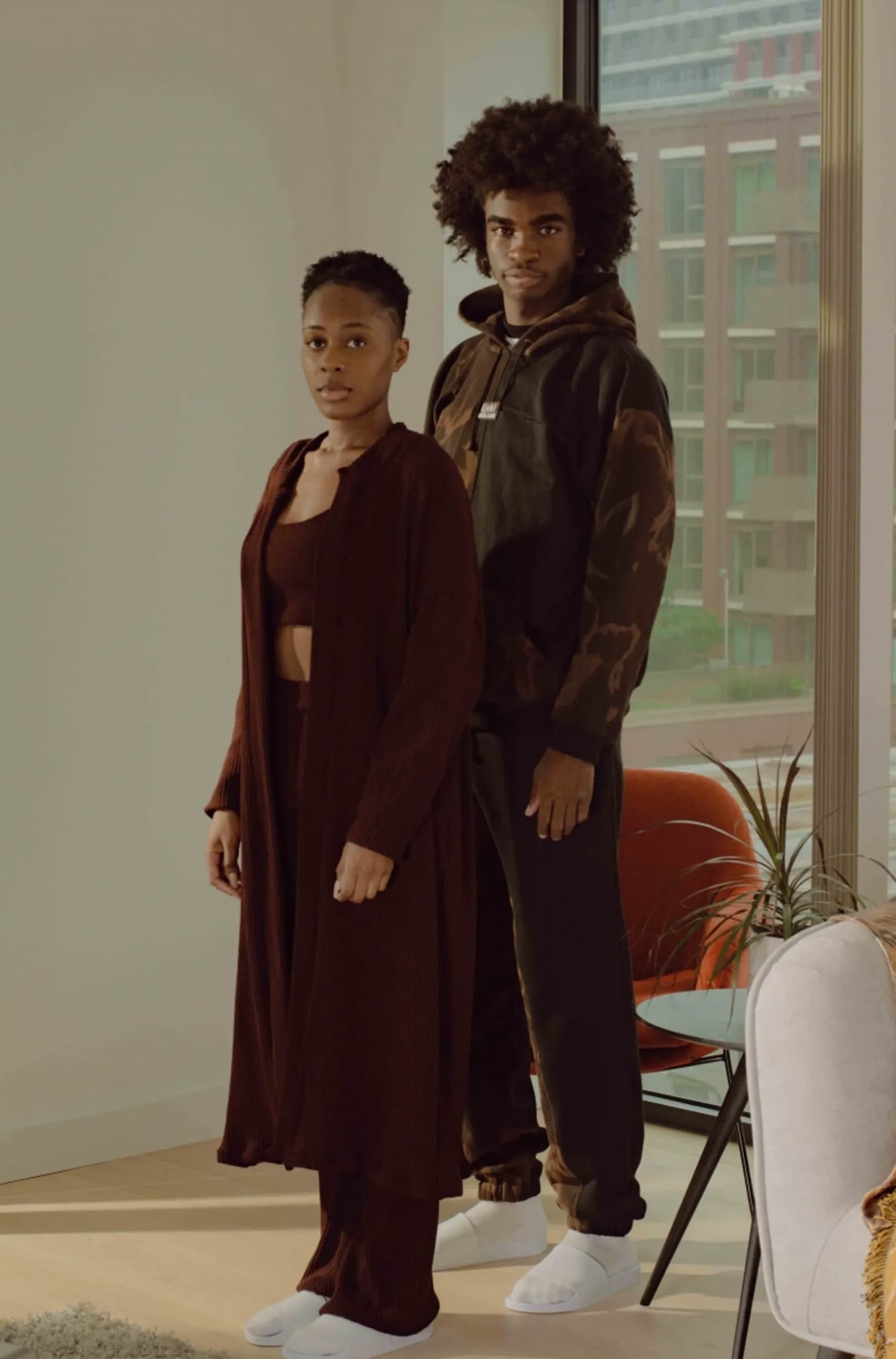Review of London’s Fall 2021 Spring 2022 Fashion Shows held in June 2021 including Bethany Williams, Ahluwalia, Abigail Ajobi & BA Fashion at Central Saint Martins
London’s Youth Quake
Emerging from the Shadow, A New Generation Spurs to Fashion Greatness With Creativity and Personal Values
By Long Nguyen
Sakeema Peng Crook, the dancer, artist, trans activist, and New Wave creative, performed a short art film titled Everything is Temporary as an opening statement for this edition of London Fashion Week, a mixture of Fall 2021 Spring 2022 primarily digital presentations. Crook’s performance stimulates the rebirth of British fashion and cultural arts with vivid close-ups and slow-motion movements and wearing various looks, including one sleeve cropped white twisted top and skirt. And the idea that fashion and the creative arts will be leading the cultural reopening of London.
However, the real action in London took place over ten days before the official British Fashion Council three-day schedule that started last Saturday and ended today with a string of digital presentations among the scattering of showroom appointments. This London Fashion Week, though, isn’t so much a full Spring 2022 season showing. One exception is the colorful video show from Qasimi and the all-white collection ushering renewal by Jordanluca. Instead, the three days were more of a placeholder with mainly inspirational treats sponsored by the hair brand Toni&Guy and a series of films from the University of Westminster featuring designs from the BA Fashion Design graduates.

Qasimi 
Jordanluca
On the early evening of 8 June, the 102 bachelors of the Class of 2021 graduates of the BA Fashion at Central Saint Martins showed their graduation work. Some students modeled their own ‘thesis’ creation or their friends’ worn other garments in a giant celebration of creativity. With the raw energy of their work, they showed outside the courtyard of an industrial studio with a raised runway covered in a multicolored patchwork of recycled fabrics with artfully handmade sculptures placed strategically to fill the vast open space. One such sculpture included an inflated transparent duck wearing a blue sunglass made by the print student Xavier Chen; another was a mannequin form made from used light brown cardboard boxes.
The old-school craftmanship feel of the staging set corresponds to the students against the pervasive waste and excess consumption prevalent in the fashion system today, perhaps getting worse in the immediate post-pandemic rush to buy what seemed to have been fifteen months of restraints. However, this raw feel staging was a giant platform for creativity, more so than so many of the laboriously expensive fashion sets paid for by the high budgets from many luxury brands. Unfortunately, lost within some of those expensively crafted stage sets are the lack of innovative ideas, a second thought to churning out more and more product drops.
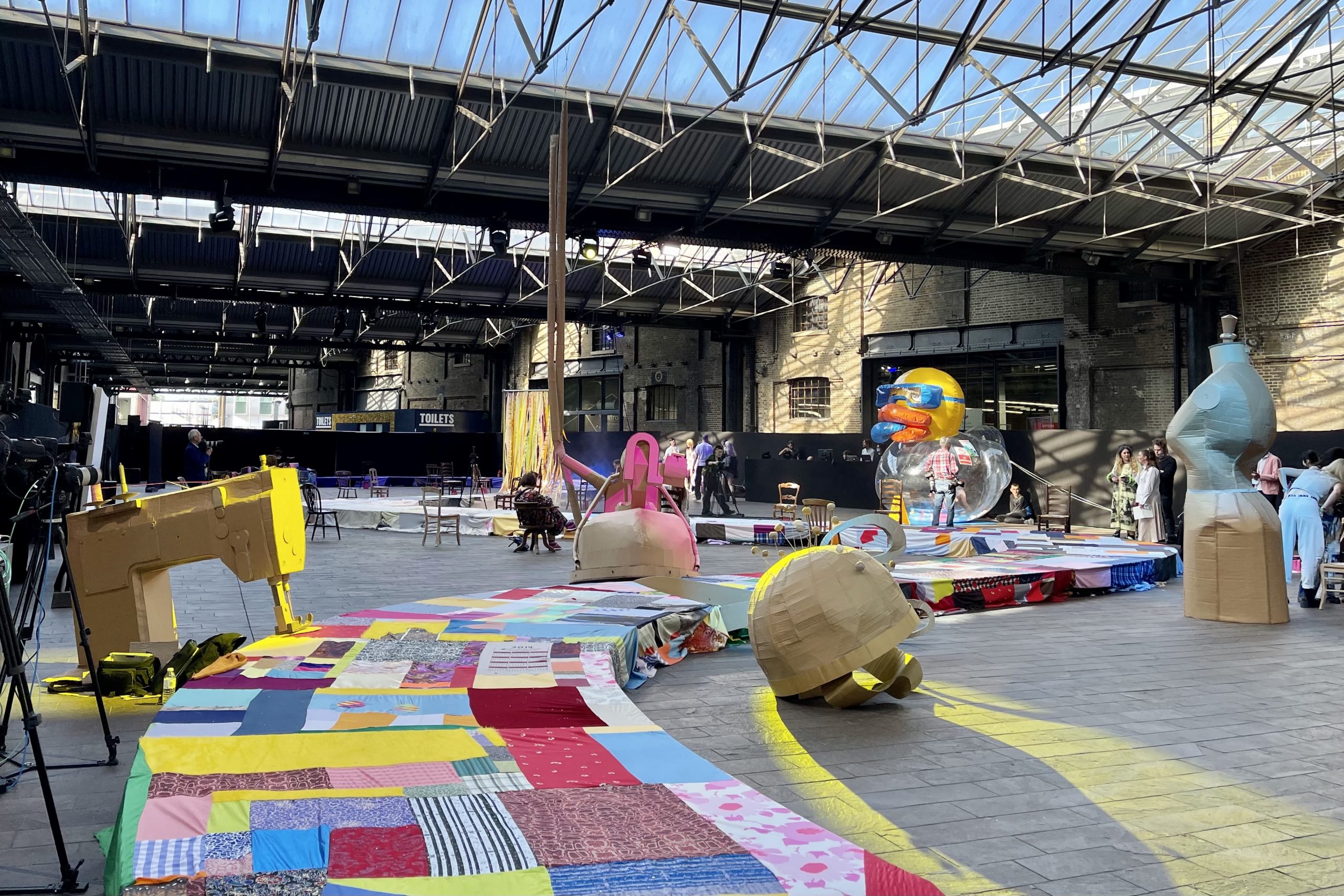
Courtesy CSM
In fashion, creativity can take so many shapes, curvatures, and in so many rituals, both mundane and startling.
It is rare today that all these elements, from conception to crafting, can come together in fashion as expressed by how designers made the clothes, yet here, the work of these students are the primal screams of what true fashion can be. Each of the 102 runway outfits presented was akin to personal monuments, each a short story of unbound imaginative fashion before the advent and the constraint of commercialism. But, more importantly, the germ of the future of fashion, both in aesthetics and in products, lies in these students, all who have firmly embraced and practiced the idea of making and consuming fashion responsibly with actual actions, not just marketing words like sustainability.
The year of lockdown has forced these students to face circumstances beyond their control, indeed beyond anything they could envision. Yet with little access to the interactions with others as the central tenet of fashion education, the learning continued in whatever ways feasible.
“This has been the most unreal year to graduate, and it has taken a village,” the student Charlie McCosker said next to the picture of the red suit with a giant headdress made from cans and plastic trash.
“I wouldn’t say the past year has changed how I see the fashion world – a space where wild creative thinking can run wild. I don’t think the pandemic has stood in the way of that at all,” Seli Arku-Korsi, this year’s winner of the Class of 2021 L’Oréal Professional Young Talent Award, said via Instagram direct message. “I don’t think it was too tough creating during the pandemic. Probably the most challenging thing was the lack of space to let the work breathe. Constantly seeing your work was a bit jarring to the point of having dreams about it,” he said, elaborating on the need for some distance to allow in a fresh look.
“It was difficult in having to create my garments as we were so restricted in the facilities of sewing machines and printing, which was probably the most difficult for me,” Liz Marine Shin, a fashion print student, said via Instagram.
“This year has been challenging! I spent the entire school year working remotely from NYC. However, I feel like one of the most valuable and priceless factors when thinking of Saint Martins as a university is the experience of the environment and the overwhelmingly creative and innovative space. The thought of missing out on this energy that is no doubt heightened x10 by being a final year student most definitely made me anxious and frustrated,” Dylan Etienne-Ramsay, the joint first runner up of the Young Talent Award, said via phone from Brooklyn.
The CSM students embraced the extreme of creativity without any hindrance of commerce in their experimentation with shapes, textiles, and garments themselves. The handcrafted materials used by the students added a different way of viewing fashion from less industrial perks amidst the apparent nods to core issues of gender identity and body consciousness on the one hand and of innovation of artisanal craftsmanship on the other.
Charlie McCosker’s Future Shock red crop jacket and matching cutout short pant drum machine suit incorporated a small sound system wired with the embroideries connected to speakers via a Bluetooth circuit board sown inside the jacket. The beads on the pantsuit are from blue cans collected from trash on the way to school, and the oyster shells embroideries come from Plett, South Africa.
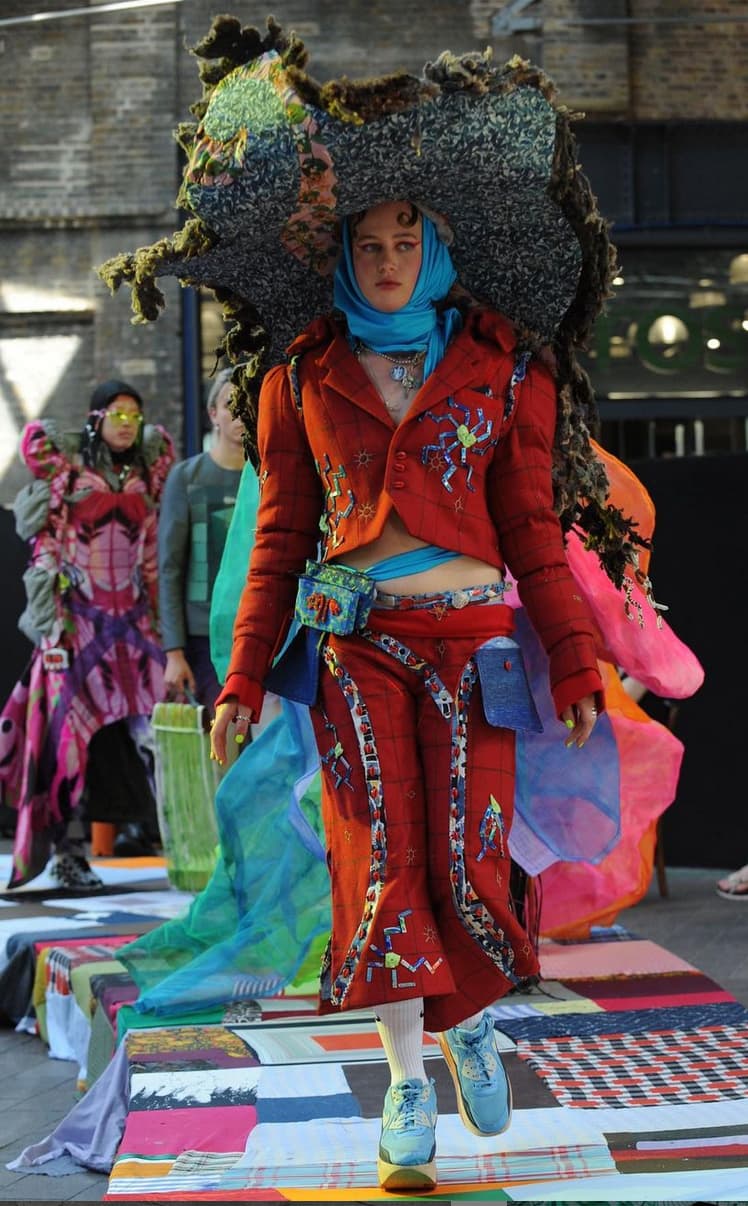
Charlie McCosker
Courtesy CSM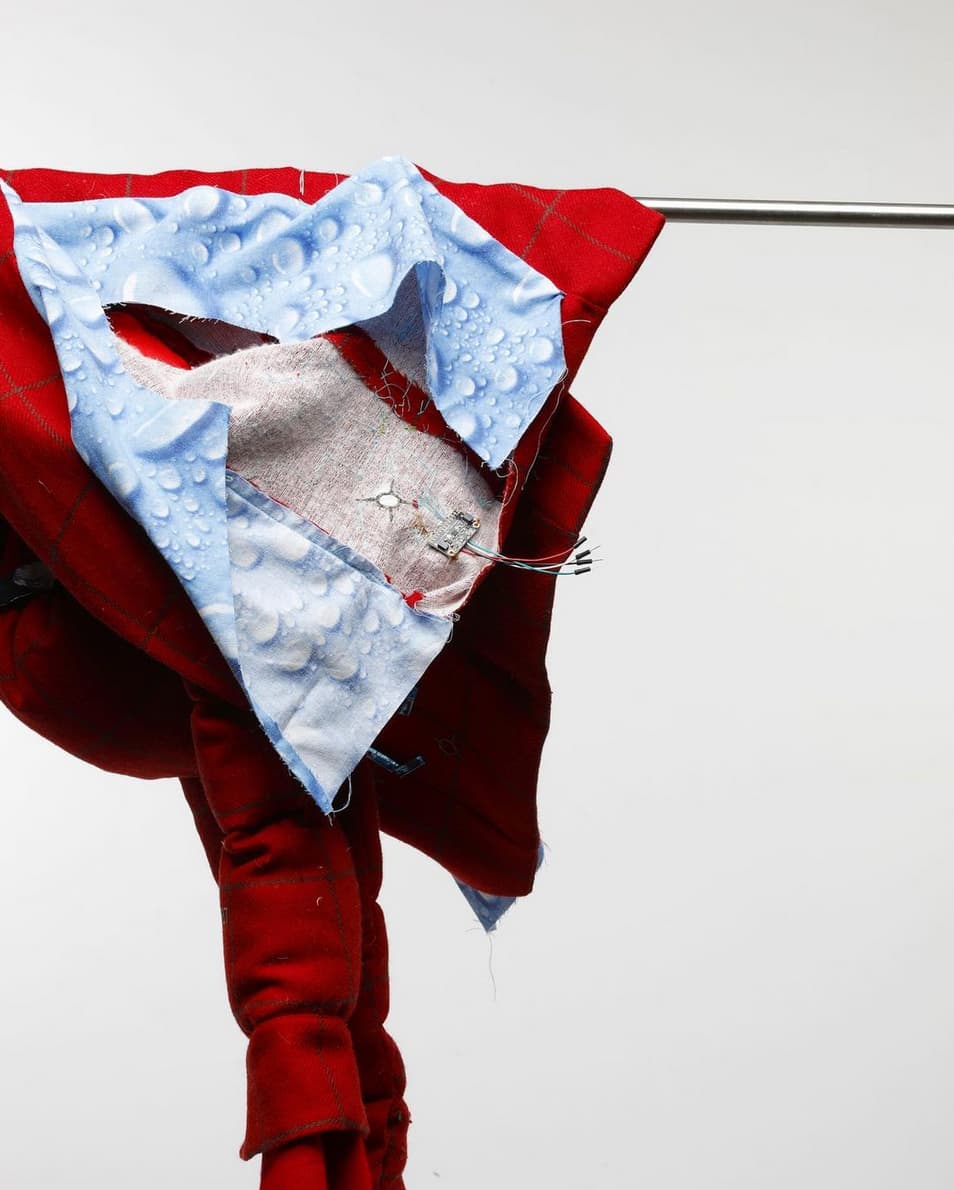
Charlie McCosker
Courtesy Charlie McCosker
“The entire collection is made from waste with nothing new in the making, from the threads to the fabrics. Everything has been donated, collected, or found at markets and car boots. For example, tweeds made from waste yarn and donated by Magee’s Donegal and gorgeous silk offcuts by Liberty London, and fabrics on trousers pockets made from beach waste and duvet covers as lining,” McCosker detailed his process of making this look on his Instagram.
The knitwear student Jamie Howes made a colorful partially shredded knit ‘sculpture’ with moon crescent headgear, an outfit worthy of the Comme des Garçons runway. Howes received the joint second runner-up to the Young Talent Award. The fashion design and marketing student Ellen Poppy Hill said her voluminous textured layers of navy blue knits ‘squoctopus’ outfit made from donated garments the hems of hand weaved plaid trousers from scrap fabrics. Steven Chevallier, a knitwear student, incorporated a colorful structure of wave-like fragments into a circular top.
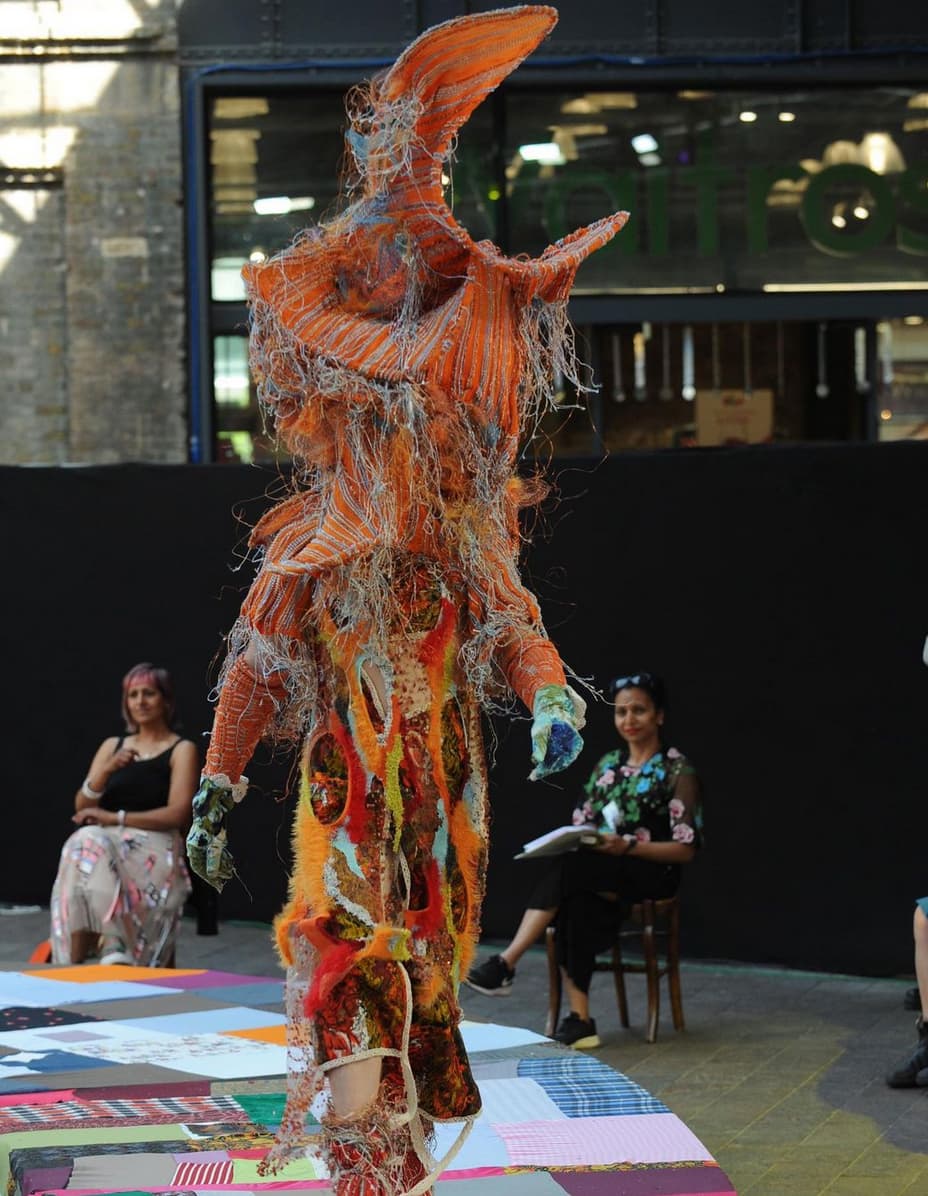
Jamie Howes
Courtesy CSM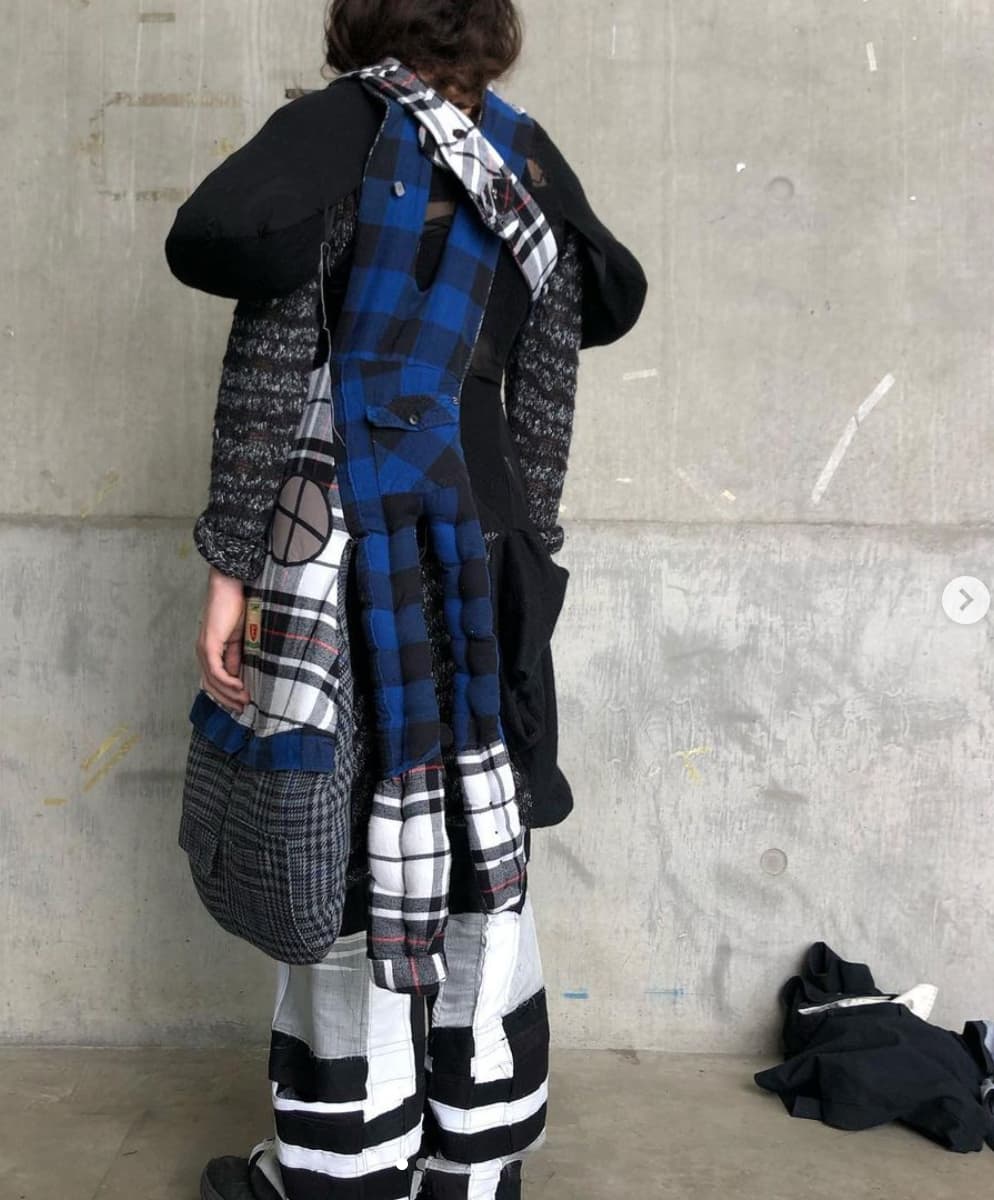
Ellen Poppy Hill
Courtesy CSM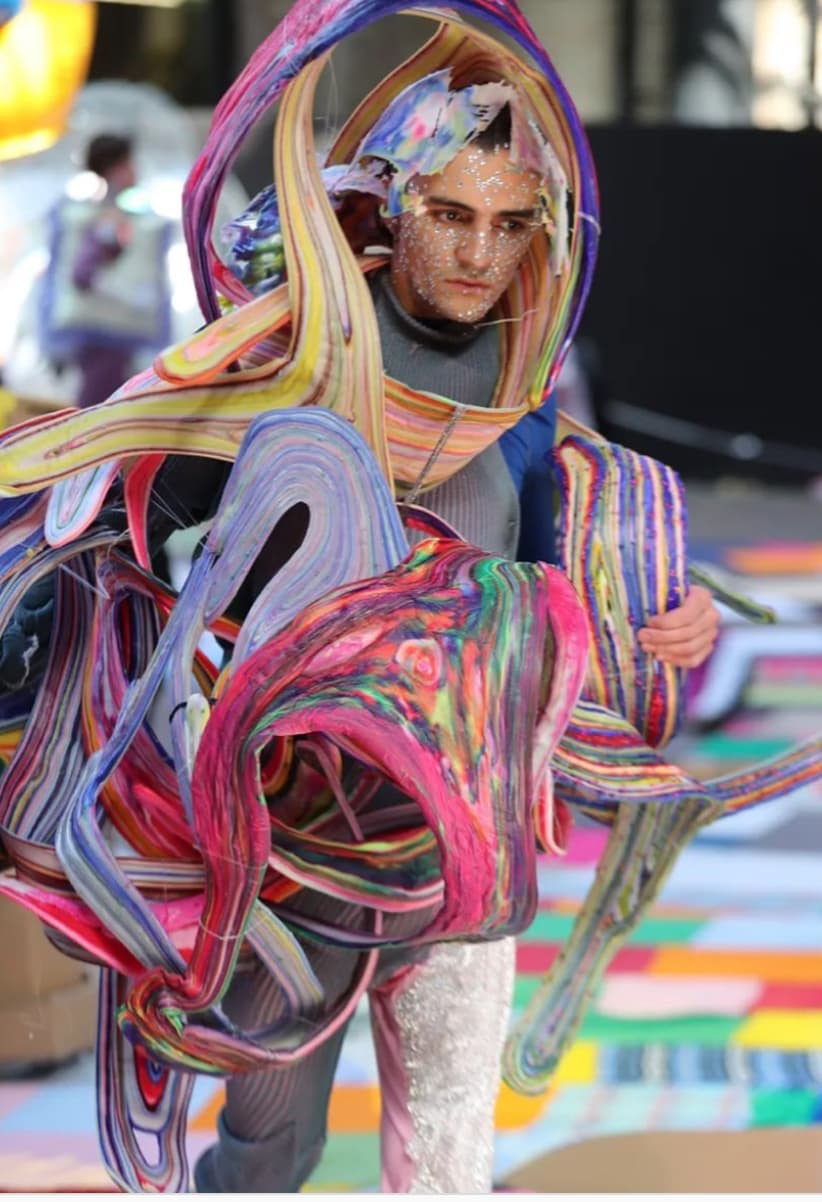
Steven Chevallier
Courtesy CSM
Boy Kloves, the LA-London student, created a boxy green patchwork surfer suit made from deadstock silk and vintage Hawaiian shirts and a surfer board culled together from the leftover scraps to produce his graduation look. The print student Arf Barkley introduced moving parts in a sheer white dress with dangling spirals.

Courtesy CSM
Bysanz Baisen Zhou’s pink and Fuschia print dress with elevated shoulders and light violet pants represents the post-human cyborg figure with complicated knitting techniques that transform the surfaces of the knits into the look of wool fabrics. Zhou’s fascination with digital cultures and the idea of virtual utopias is parallel to the current issues of identity and gender across global cultures.

Courtesy CSM
Claudia Gusella’s white egg dress is an extension of her dreams of the possibility of low-cost fashion with as minor environmental damage as possible. Kaya Chie juxtaposes the duality of ‘imperfect/perfect’ onto a light green stretched and pleated one-sleeve top with one raised shoulder scarf made with an Australian wool jersey and an extended knit lace skirt. “The collection is a journey finding beauty within imperfection, showcasing the asymmetry in nature,” Chie said.

Claudia Gusella
Courtesy CSM
Kaya Chie
Courtesy CSM
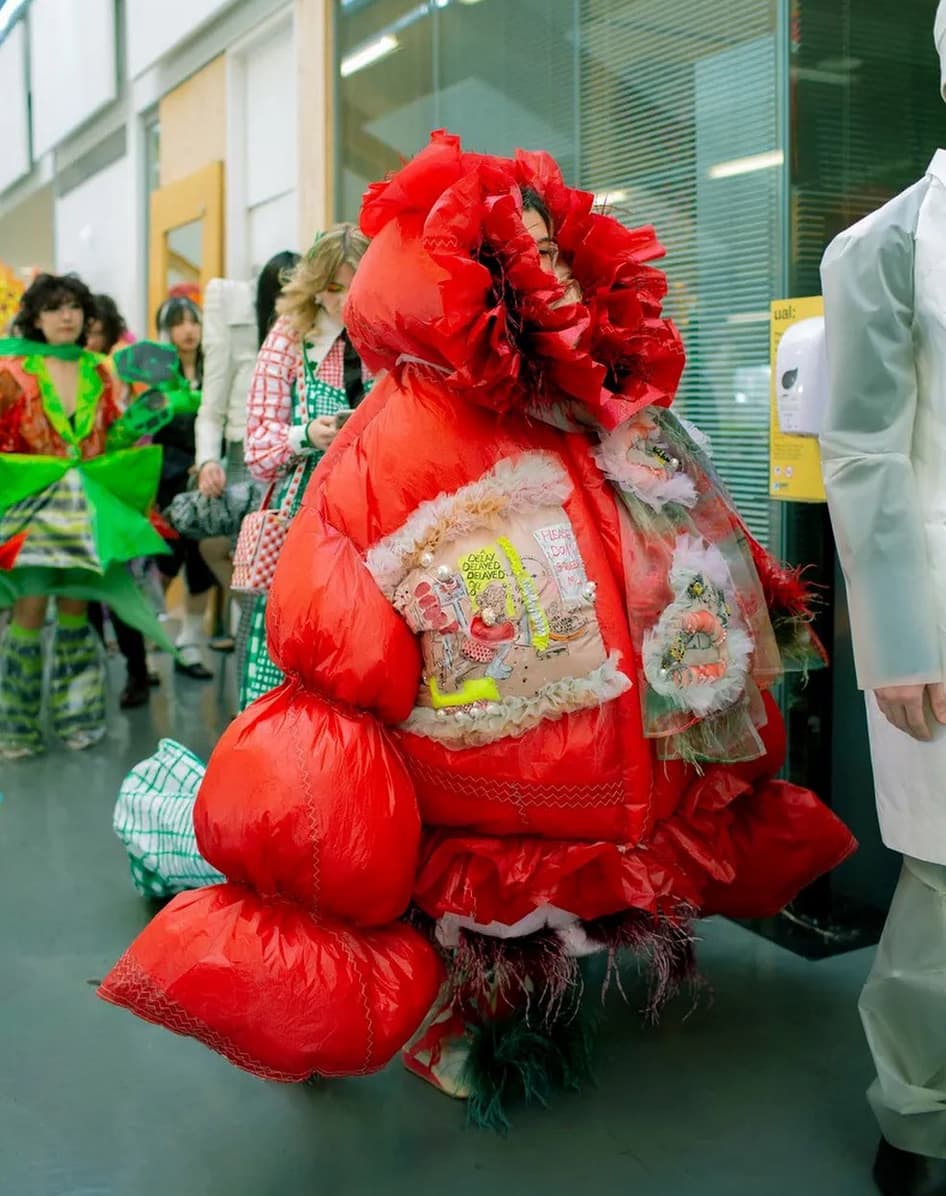
Courtesy CSM
“I was inspired by childhood memories of how my mum used to dress me in oversized clothes, which was the main aesthetics. So even though I turned 23 this year, I still would get called a 17-year-old, which I wanted to use as this ironic idea of me as an adult wearing extreme oversized wear,” Liz Marine Shin said via Instagram direct message. Her red outer red puffer coat played with the enormous proportions but with particular couture detailing such as the ruffle trims and lace embroideries.
Celine Yu Hei Kwan, a major in fashion print, showed a colorful print dress with an inflatable skirt and hat. Hollie Dow, a womenswear student, wore the high collar shredded dress and silk chiffon overskirt with hand-dyed strands of fringes with motifs from Judit Reigl paintings by fellow womenswear designer Tom Kindon. At the same time, Kindon had on the mustard sleeveless top with hanging fringe and ecru pants by Dow.
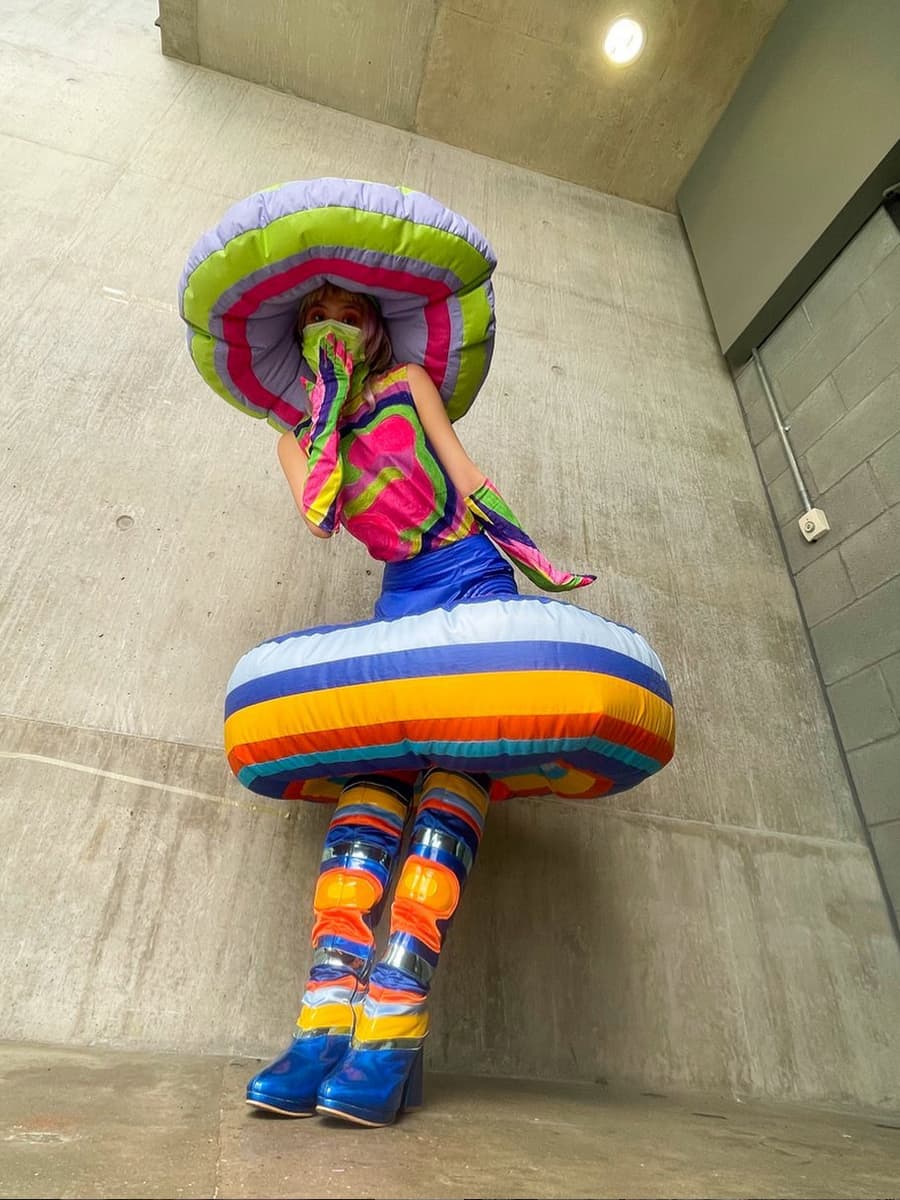
Celine Yu Hei Kwan
Courtesy CSM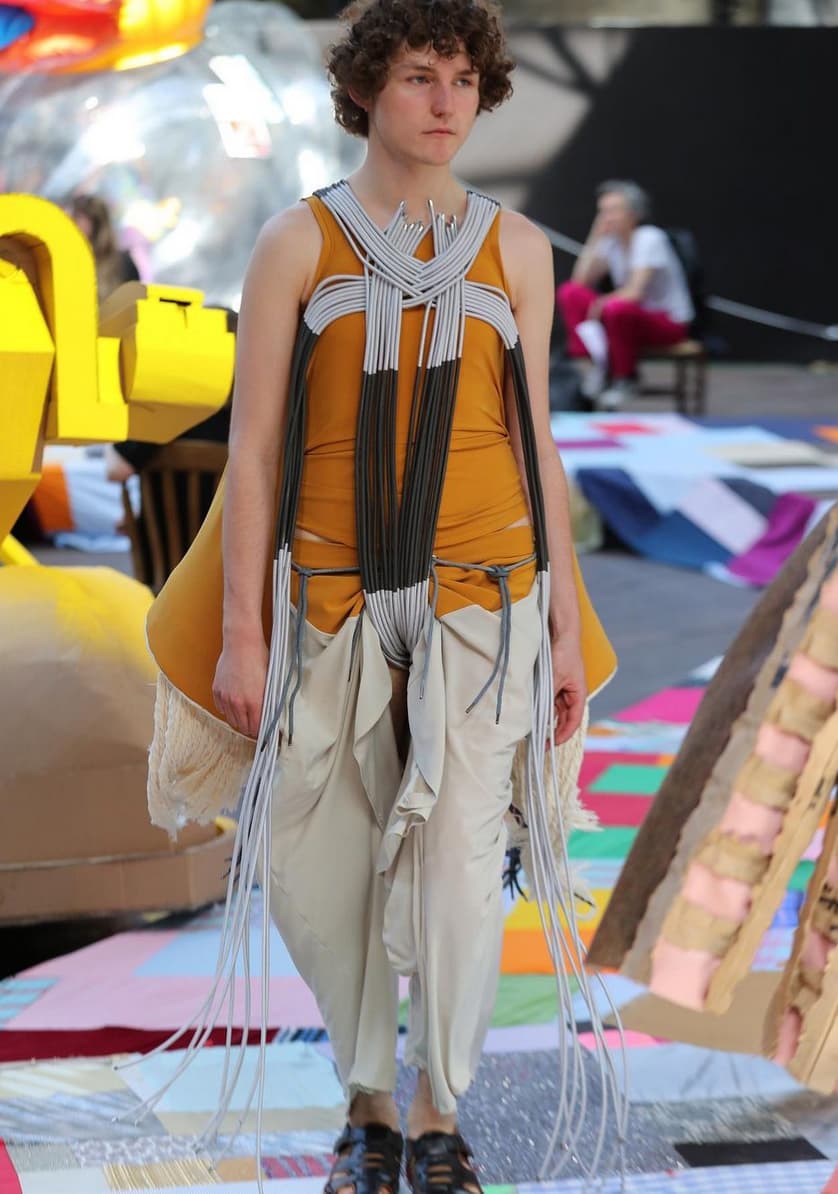
Hollie Dow
Courtesy CSM
Karina Bondareva, the joint first runner-up Young Talent Award print student, documented the arduous handcraft process to create the circular headpiece. She made from carefully placed together on the specially cut pieces of felt wool, with matchsticks arranged into floral patterns, and then hot glue everything together without any needs for actual sewing works. Bondareva hand-dyed the red and light purple of the felt wool and the different coloration of the matchsticks. The asymmetrical skirt came from different pattern batches of colored hot glue made into specific arrangements, then dried into segments to be glue into the actual skirt.
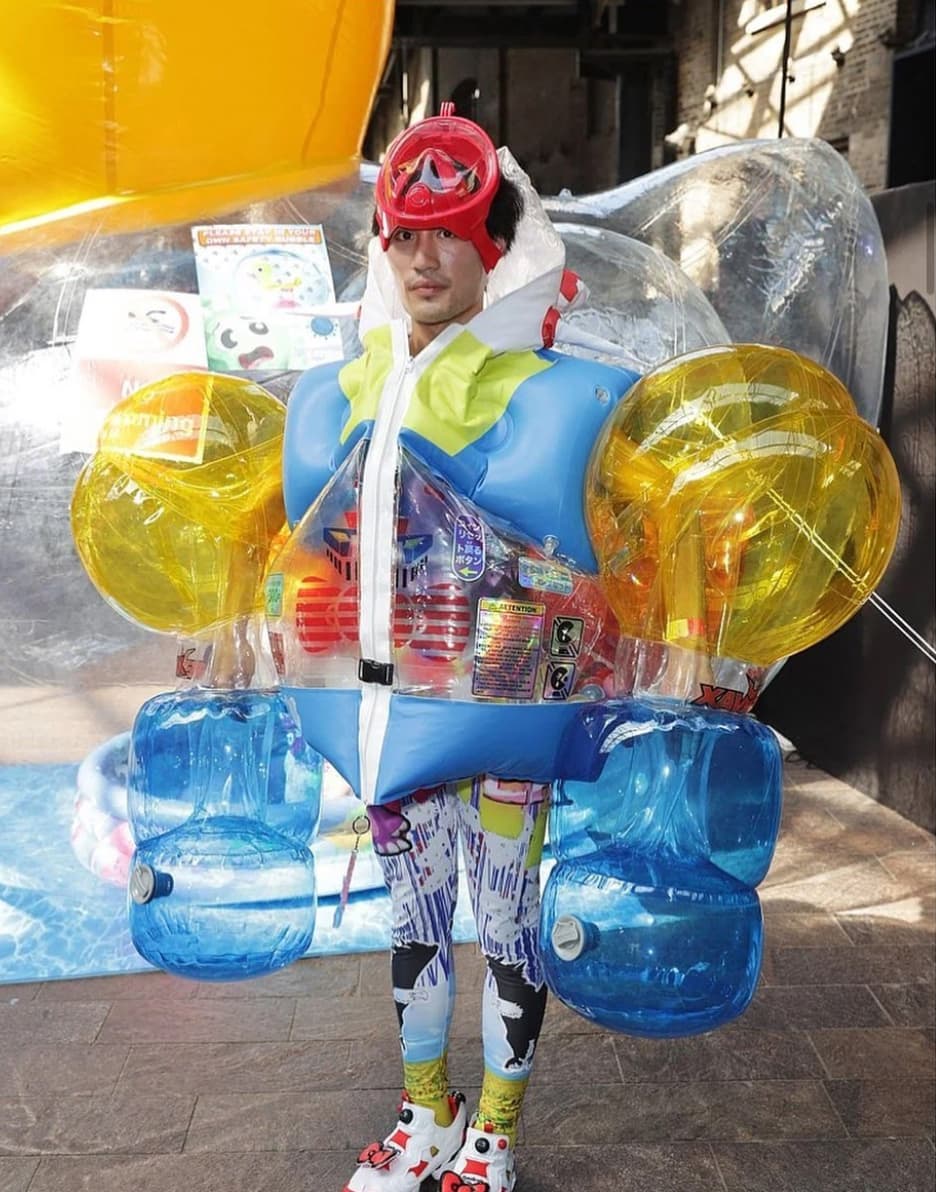
Karina Bondarova
Courtesy CSM
Xavier Chen
Courtesy CSM
How to describe Mathilde Schaub’s sparkling silver and white flaking long flare conical head ‘dress’? With two people inside, one being carried by the other with her head protruding, flipping backward. Schaub’s head sticks out of the top of the silver dress as she was carried down the patchwork catwalk by another model inside the dress itself.
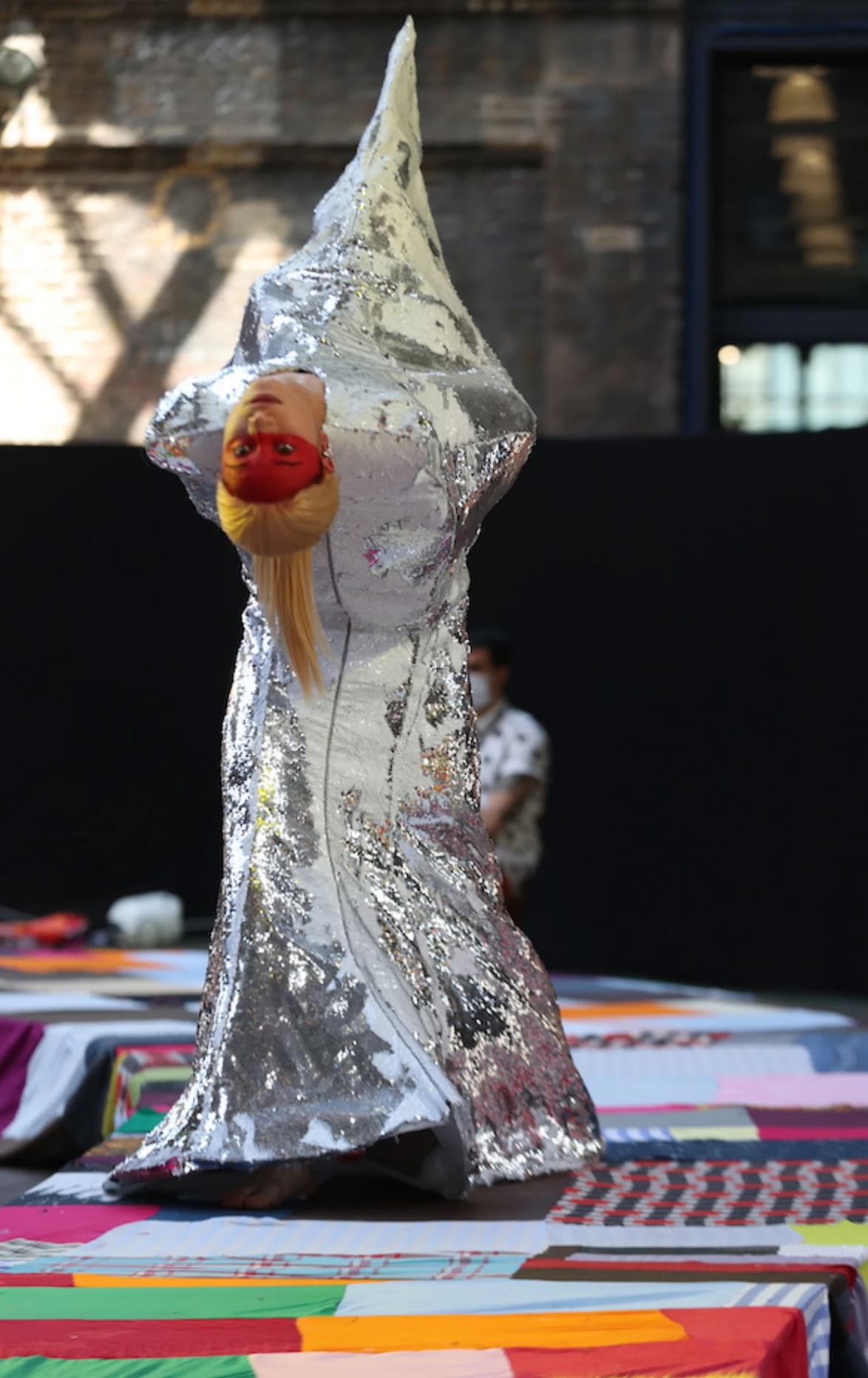
Mathilde Schaub
Courtesy CSM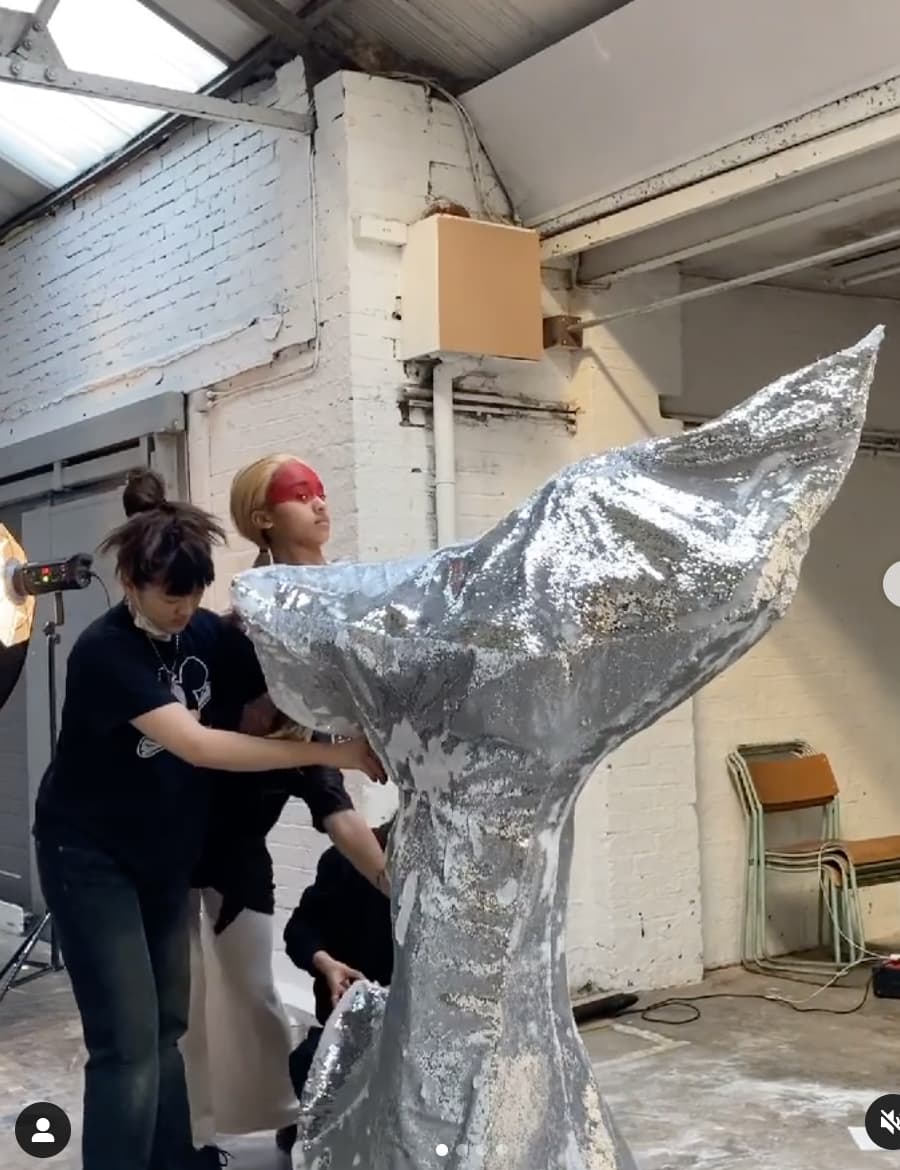
Mathilde Schaub
Courtesy Mathilde Schaub
“My collection is inspired by Donna Haraway’s feminist writing and her ‘Cyborg Manifesto,’ a work which criticized identity politics of traditional feminism based on a binary definition of gender. My collection is to metamorphose the human figure into non-binary characters: mixing the bodies of a man and a woman to make one garment for both,” Schaub, the womenswear student, explained her concept in literally merging a man and a woman within this silver dress with conical head shapes.
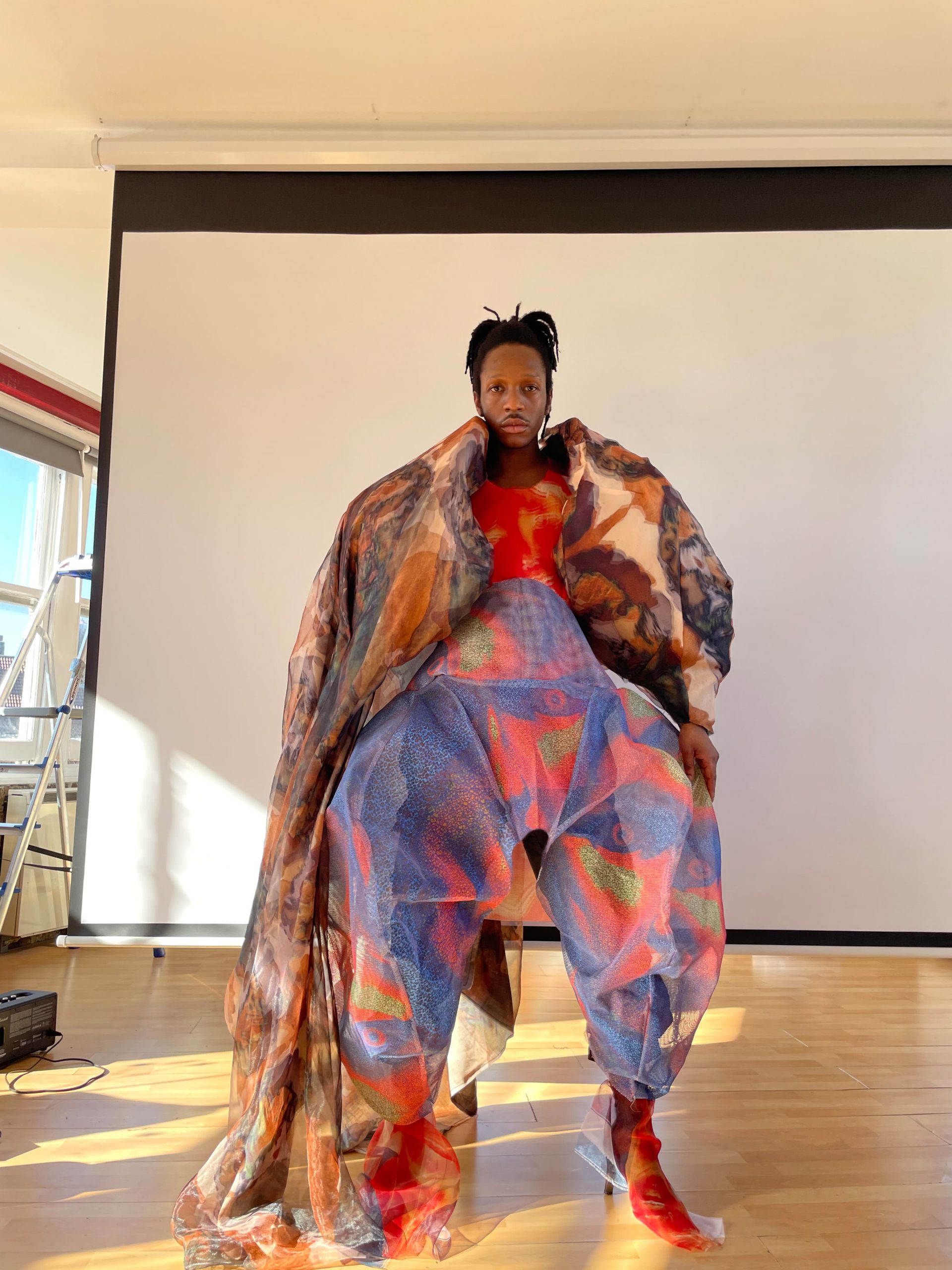
Courtesy Seli Arku-Korsi
Seli Arku-Korsi showed a throw coat with a special 3D print with organza fabrics layered for the unique visual effect. “In my project, I take my paintings and expand upon them by – turning them into prints which I then manipulated to create a mirage-like effect, where the movement of the garment heightens this effect,” Arku-Korsi explained the unique effect of the cape.
Dylan Etienne-Ramsay, the second first runner up from fashion design and marketing, said the graduation work he titled ‘An Ode to Memory.’ “An exploration of the self and the individualism through community, and examining of culture, heritage, and personal history through my childhood and young adult memories via an Afro-Caribbean upbringing.”
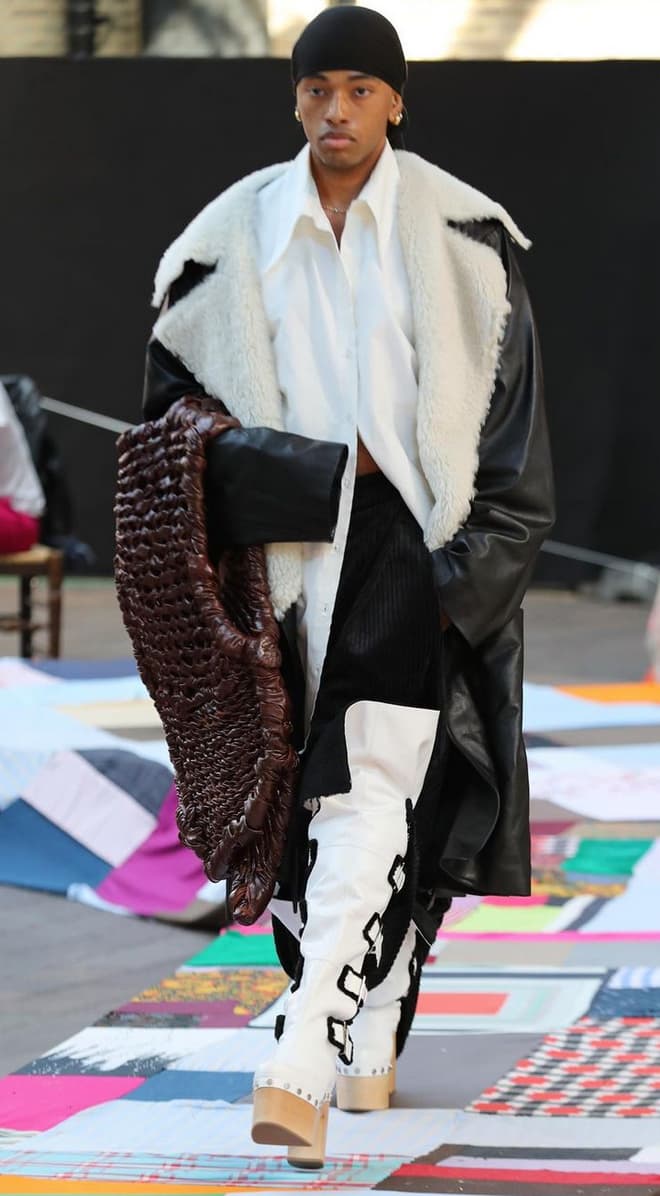
Dylan Etienne-Ramsay
Courtesy CSM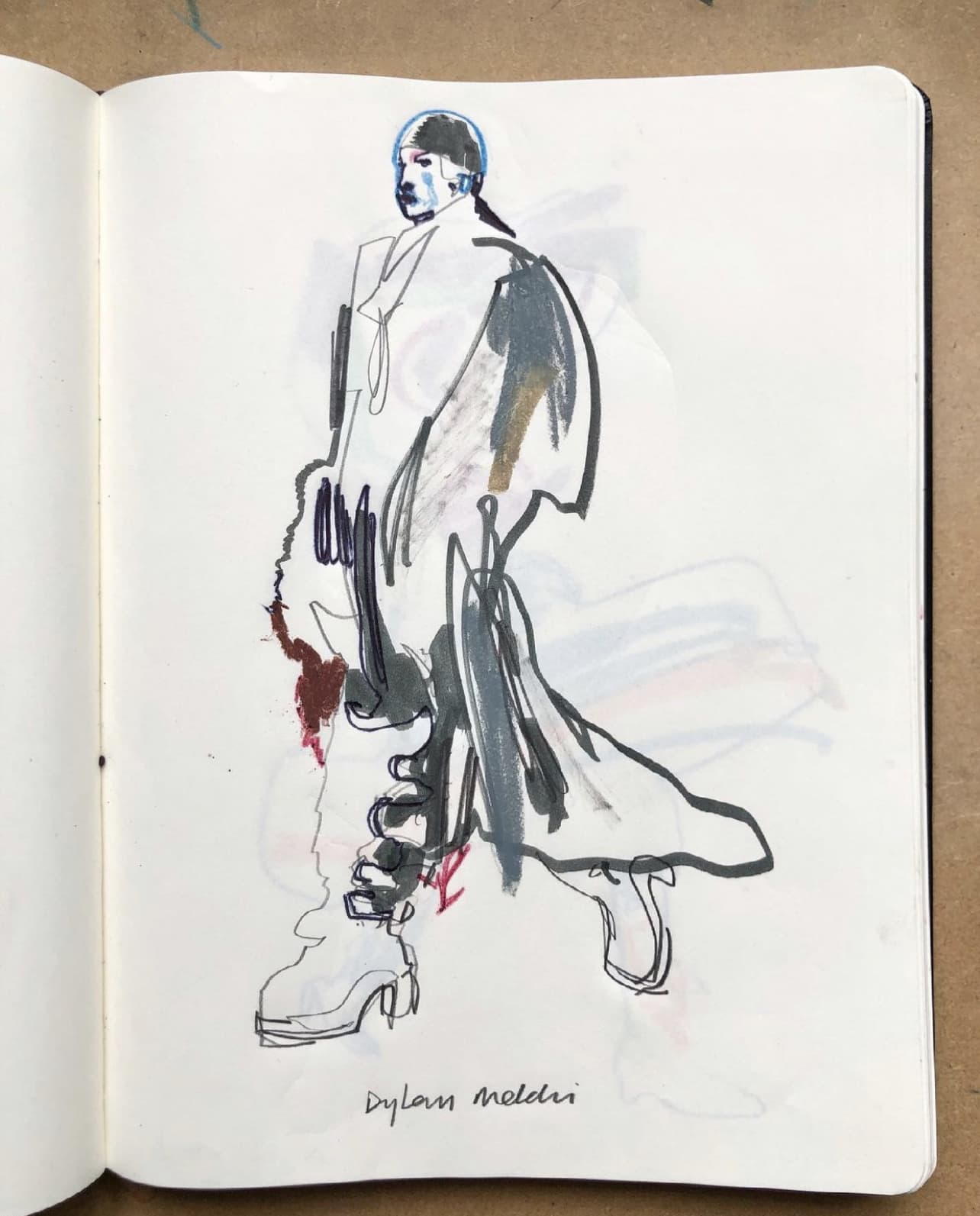
Dylan Etienne-Ramsay
Courtesy Dylan Etienne Ramsay
Illustration by Alex Mien
His show look was an oversized black leather and shearling trench, a dark camel suede belted jacket, a hand-dyed wool dress, flowing corduroy trousers, and heeled leather clogs. “A unique approach to design founded on sharp tailoring, architectural constructions, and rich, high-quality textiles. My work (officially Dylan Mekhi) embraces multicity of perspectives, proposing a distinctly raw notion of luxury via a hybrid of American and Afro-Caribbean approaches,” Etienne-Ramsay said.
“The collection explores an expression of Creole and Jamaican aesthetics, informed by Caribbean philosophy and the notion of the literary movement ‘créolite’ – an active process of forming identity,” Etienne-Ramsey said. In this respect, he shares the same aesthetic inklings pushing multiculturalism into the center stage of fashion as young British designers like Bianca Saunders, Priya Ahluwalia, Grace Wales Bonner, Saul Nash, Nicolas Daley, and Paria Farzaneh.
In this highly charged era where politics and fashion sometimes meshed uncomfortably, the student Stevie Boy crafted his orange giant rectangular top with sewn-in figures denoting the faces of protest in Hong Kong. The designer student wore a mask to hide his identity. The actual protesters did in recent years in the semi-independent city now losing much of its historical democratic institutions. On the back of his show look is the words ‘Fight for Hong Kong’ inscribed with a bit of irony.
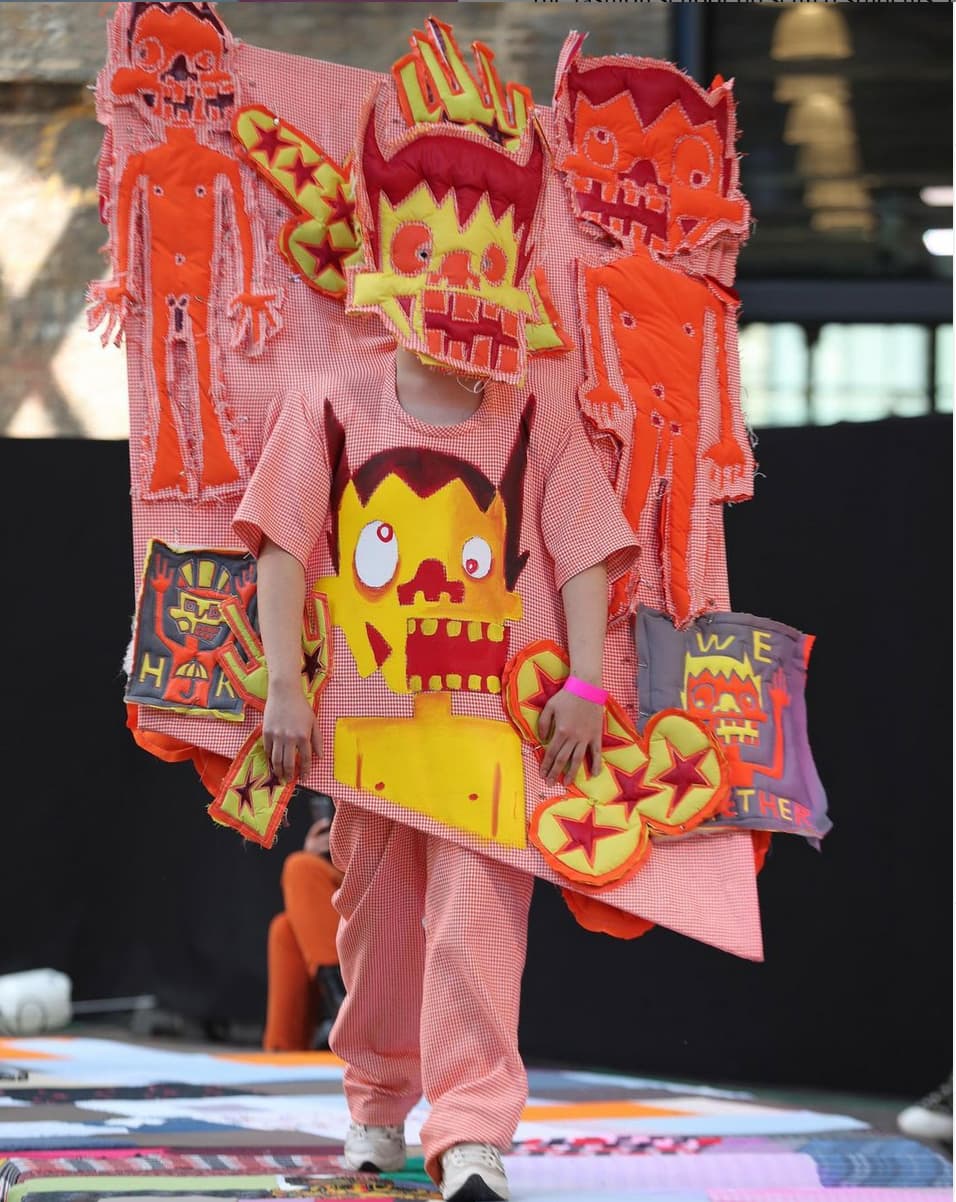
Courtesy CSM
These CSM students have already adopted this microcosm of storytelling to model their fashion brands in the future. Now, these symbols and actual real commitments, not artful oratories, echo the younger generation’s championing new footholds in anchoring societal values to change the industry at large. Yet, more than anything, it is the courage to uphold their creative convictions that were most visible on each of the outfits selected by the graduating students.
In the work of these graduates, some of who will become the following breakthrough talents conquering the industry, there are no expedient borrowings from art or other sources as a driver of their fashion creativity in work. Instead, the students drew from their personal lives and experiences coupled with pushing the notion of experimentation.
There is a reason that the biography of every British designer always includes their alma mater, whether it’s Central Saint Martins, the University of Westminster, London College of Fashion, Kingston University London, or the Royal College of Art. Whether in the BA or MA fashion program, associating with a specific university is a batch of honor, a sort of elevation into that lofty sphere of creativity.
This London digital fashion ‘week’ cannot be measured solely by the number of days or by the lack of any participation from major brands.
Instead, the young designers, mostly recent university graduates, are genuine about their comprehensive worldview as intrinsic to the kind of fashion they espoused with their aesthetic, products, and steadfast pledge for a transparent system. The central question that lingers on is how will luxury fashion change as these young kids bring their values as they enter fashion both as designers and as consumers, with the strongest and impactful work coming from Bethany Williams, Priya Ahluwalia, and Abigail Ajobi.
Bethany Williams, a 2017 MA graduate of The London College of Fashion in Menswear, launched her new collection with the same enthusiasm for social responsibility that is now synonymous with her fashion work with a film titled ‘All Our Stories.’ The fast-paced narrative film, based on the oral and written traditions of stories passed on from mother to child, is a collaboration with the artist Melissa Kitty Jarram and her workshop at the Magpie Project running the storytelling gatherings with illustrated narratives using waste book covers donated by Hachette for drawing artworks.
In her work, the South East London-based Jarram focuses her illustrations and paintings on the female experiences of hardship and violence. “Words that no longer fit the same way because life has stretched and changed its shape, but the moral of the story remains,” Williams wrote on her Instagram.
What we noticed through the storytelling workshop was that the moral in each story came back to kindness, care, and respect for one another and how these traits, while important in childhood, have just as much meaning in adult life.
– Bethany Williams
The collection will help firm up the workshops expanding the capture and amplification of these stories with the Magpie Project, where 20% of this collection will be donated to help the East London grass-roots organization supporting women and children homeless or at risk of homelessness.
As with folklores passing from generation to generation, these childhood stories begin with the child. It is within the framework of children’s clothes inspired by the V&A Museum of Childhood’s garment archives, particularly the children’s skeleton suit from the 1800s designed for play. The skeleton suit consisted of a tight coat or jacket buttoned to a pair of high waist ankle-length pants, specially tailored for children rather than as a resizing of adult clothes.
Williams reworked the idea of the skeleton suit into a white printed via eco-friendly ink by Orto Print in Peckham, south London, next to Brixton, slim pantsuit with a cropped four buttons single breast natural shoulder jacket and a matching print shirt. The pants of these new skeleton suits, Williams first detailed exploration into tailoring, also in black wool with a sleeveless jacket-vest from a donation of dead stock Merino Wool from Lanificio Ermenegildo Zegna has a frontal crotch pouch.
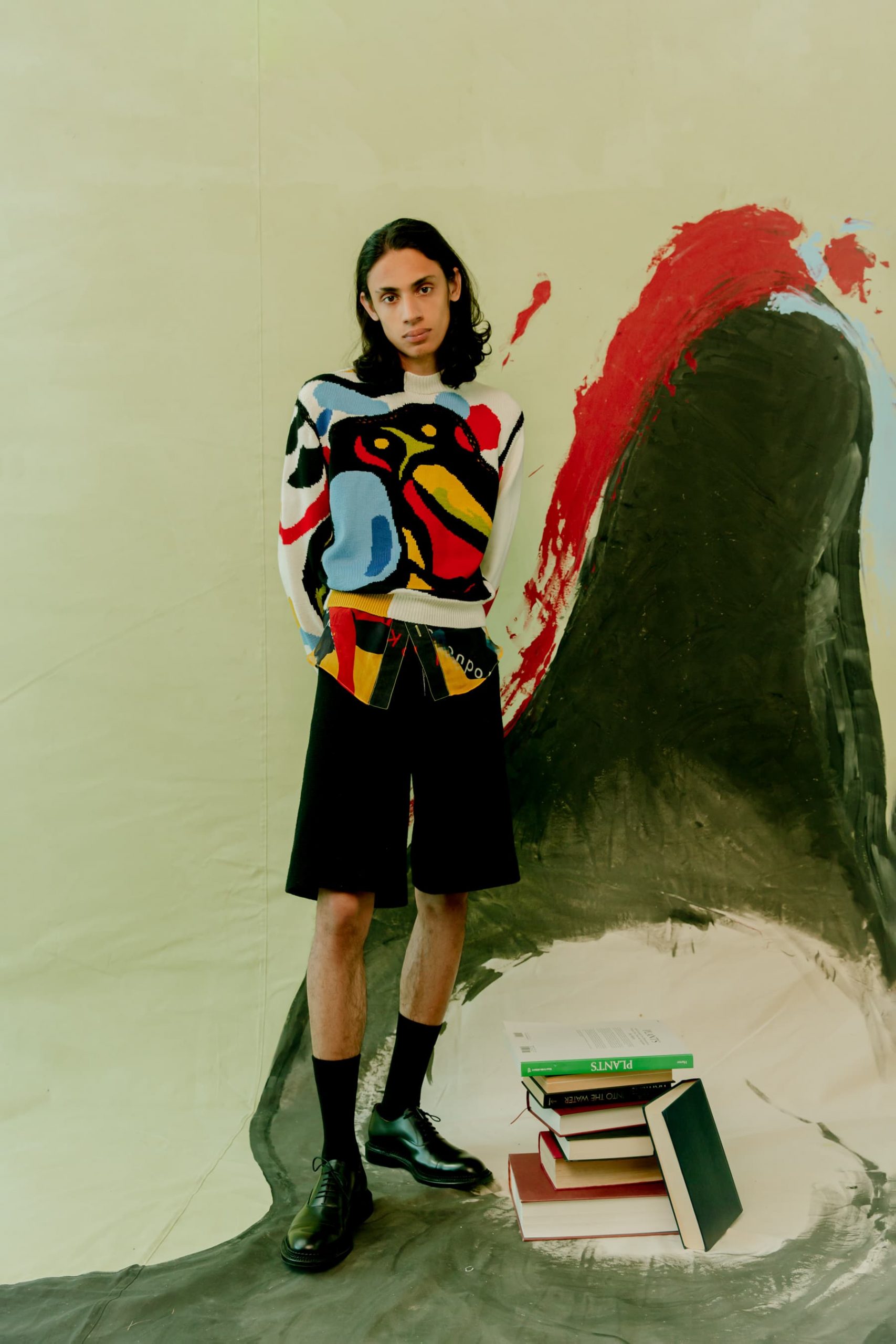
Standouts in this collection are the various hand-knit colorful sweaters for kids and adults alike and the simple light ecru two buttons single breast wool straight jacket with cigarette pantsuit and the knit fringed brown pattern coat. All these knits are from a partnership with Manusa, a social cooperative specializing in hand techniques of crochet hand knitting and embroidery using Sesia Wool industry waste sample swatches. Woolmark also helps in sourcing waste from local suppliers for hand knitting these colorful patterns sweaters. In addition, a black and a light brown print corset used cutoffs from production, where the Welsh designer Rosie Evans replaced the traditional boning with material from fruit packaging waste.
Williams has expanded the idea of fashion, anchoring the notions of charity partnerships, the manufacturing ethos entrenches and localizes within a specific community, and the standards of environmental consciousness as central pillars of her brand, more so than seasonal stylistic changes.
The current winner of the 2021 BFC/GQ Designer Menswear Fund and the 2021 Queen Elizabeth II Award for British Design, Priya Ahluwalia, is changing menswear fashion, injecting vibrancy with her multicultural approach inherent in each of her garments. Ahluwalia, a 2018 BA menswear graduate of the University of Westminster, draws from her Indian-Nigerian heritage and South West London as the foundational base of her menswear brand launched in 2018 with an innovative approach to streetwear and tailoring using primarily dead stock and repurposing vintage fabrics.
The designer presented a third film for the Spring 2022 men’s collection with a debut of the women’s titled Parts of Me directed by Akinola Davis Jr., featuring a collaborative bag with the British brand Mulberry. The film revolves around the transcendental embodiment of black hair and how hairstyles are a means to self-identity, expression, and even protest. The hair motif carries through the clothes with the wave print pattern, seam lines, and embroideries that reflect the decorative and highly texture Afro-Caribbean hair creations, transforming the lines of cornrows, for example, into patterns and fabric paneling for the clothes in solid colors and simple silhouettes.
The Lagos-born British graphic artist and designer Dennis McInnes collaborated again on making colorful graphic prints and laser artwork on the fabrics. McInnes mixed the baby blue, beige, and browns in the kaleidoscope in the denim pants and jackets, the sporty tricot knits and shorts, and the tailoring that includes a loose fit three buttons single breast broad shoulder pantsuit. In addition, there are new versions of the men’s shirt suits in the brown plaid shirt-pants or print sweat-shorts.
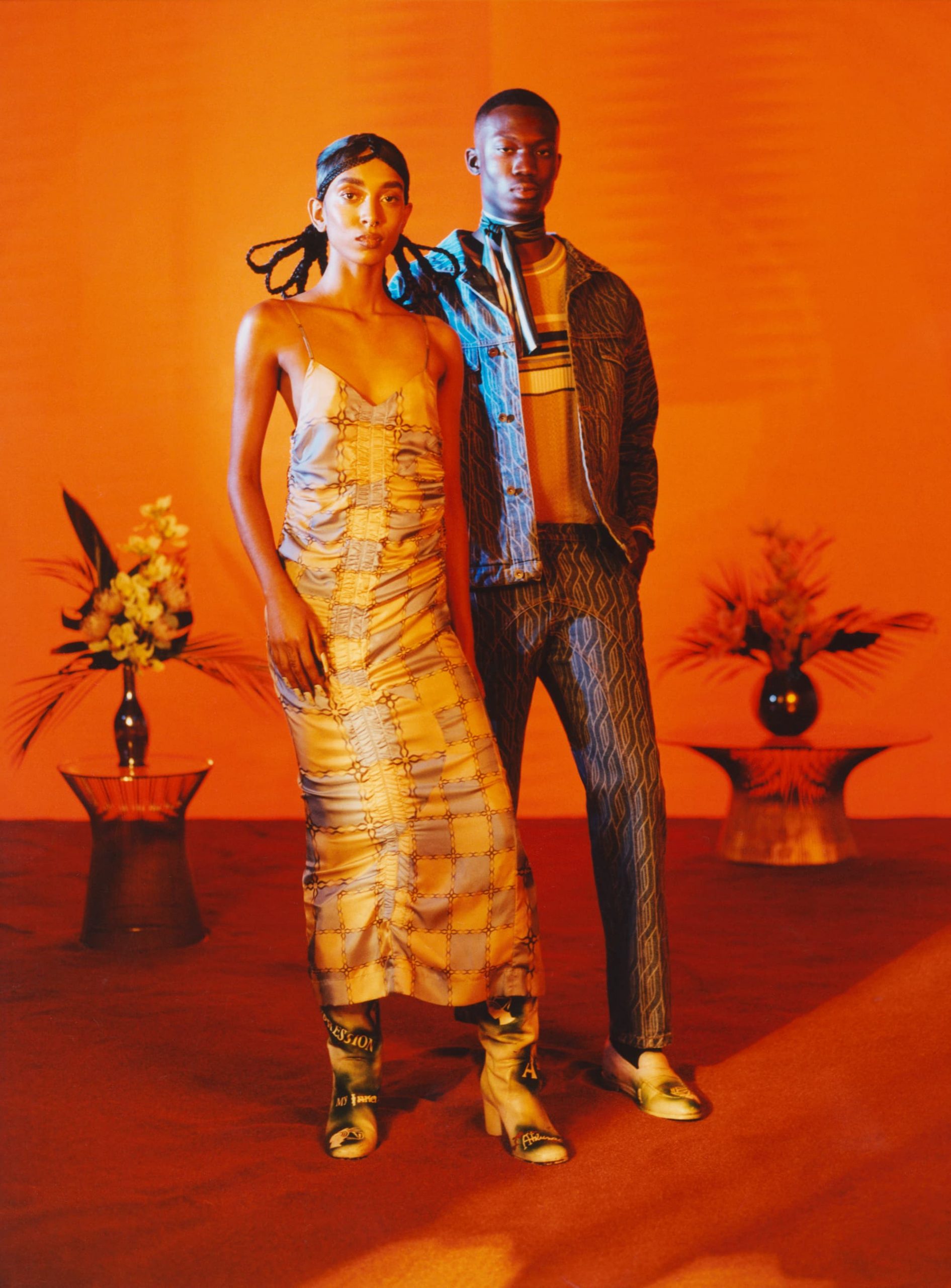
Ahluwalia’s debut womenswear is a direct offspring of her menswear, mixing the proper dosage of tailoring and sportswear. A chocolate four buttons double breast fitted jacket and relax pants with wavy white fabric inlays do not look formal in any way. An ecru and light olive square cardigan collar short coat/dress or a cropped polo collar jacket and matching flared pants have patchwork red seaming that follows the hair braiding patterns. The mismatch patchwork of brown, pink, and orange fabrics for jogger trousers, long skirts, or cropped tunic top preserve that idea of simplicity that making each piece is intrinsic to the design work.
The Yoruba Nigerian-British Abigail Ajobi, the 2019 BA menswear graduate from the London College of Fashion, is another talent choosing to work in the arena of luxury streetwear. Her mission is to “create collections that encourage people to acknowledge uncomfortable issues of injustice buried or ignored, to empower those without a voice and give back to our community.”
Ajobi launched her namesake label in the pandemic year, October 2020. As a social enterprise and a small business, Ajobi is making clothes that revolve around the issues of culture and race with thematic print-based limited-edition capsule collections that meditate on racial awareness and the eradication of institutional oppression and bias through luxury fashion.
Courtesy Abigail Ajobi
For her 2019 graduate collection, Ajobi comprised garments made from handwritten words on denim, patchworks, hand-printed utilitarian anoraks, and straight zippered coats, black and white graffiti pants, and raincoats. This thesis provided the germinating concepts that evolved into a more extensive offering in her debut Fall 2021 capsule that expanded her graffiti work into a more comprehensive range of garments.
For her second full 2021 capsule, Ajobi carries over some of the garments from the debut capsule last year in a video in conjunction with Discovery Lab. The designer made a news documentary about several couples at homes on the couches, watching the news about the lockdown. The couples wore mustard print blanket jackets and mid-seam pants, black and olive hooded windbreaker jackets and joggers and brown print tops, stone cotton wool jackets, and slim mid-seam pants.
It, not such a farfetched notion connecting the thinking from the different student ideas on fashion as they presented their graduation work to Bethany Williams, Priya Ahluwalia, or the newcomer Abigail Ajobi have particularly interwoven connections between fashion and social responsibility. For the Central Saint Martins BA Class of 2021, as for these younger British designers coming of age in a moment redefining the meaning of fashion and fashion designer, the personal values and concerns for gender equality, multiculturalism, and waste reduction are as crucial as creativity and experimentation.
“As a gay black man in the reality of today, everything and anything I do in life are political. Whether I am directly referencing my race, gender, or sexuality in my work and conversation, or even just making something as simple as walking down the street. Every living, breathing moment for me is positioned and situated within these narratives, whether I want it to or not, and whether or not it is a conscious or subconscious thing. My work is entirely autobiographical and autoethnographic – so in this sense, in its most raw form,” Etienne-Ramsay said.
These young Brits or graduates of British fashion schools are changing the contours of the fashion topography. They are injecting their values as a central tenet of their fashion vision. They are creating a fashion worldview encompassing the creative, the community support, and the personal self.
“I am my work,” Dylan Etienne-Ramsay explained the interconnectedness between himself and his work. This same sentence can apply to Bethany Williams, Priya Ahluwalia, Bianca Saunders, Saul Nash, Nicolas Delay, and Abigail Ajobi.
